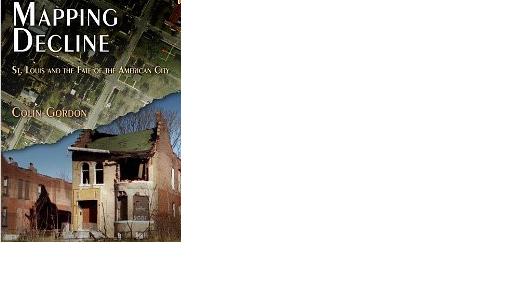 Hang on to your hats. It’s going to be a bumpy – and depressing – ride for the next few blog entries.
Hang on to your hats. It’s going to be a bumpy – and depressing – ride for the next few blog entries.
Why?
Because I’m going to be focusing on Colin Gordon’s Mapping Decline: St. Louis and the Fate of the American City (Penn Press, 2008). The journey won’t be depressing because of the quality of Gordon’s book and accompanying website – but because of the very sad story Gordon tells about St. Louis and its decline over the last half-century.
Gordon quotes an observer from the late 1970s: “St. Louis is not a typical city, but, like a Eugene O’Neill play, it shows a general condition in a stark and dramatic form.” “More dramatically than most,” Gordon says, “St Louis followed a middle-American pattern of concentrated inner-city poverty, intense racial segregation, and dramatic population less.” This pattern, he says, was “suffered by many of the nation’s older urban area, but . . . St. Louis led the pack.”
The chronology is devastating.
In 1941, the League of Women Voters reported: “St. Louis has been losing population to the county at such a rapid rate in the last few years that soon it will be left with its slums and too few taxpayers to support them.”
In 1956, a visiting French businessman noted that St. Louis “looks like a European city bombed in the war.”
In the 1960s and 1970s, “it became increasingly common to refer to the ‘bombed out’ appearance of devastated inner cities. This allusion held for cartographic snapshots of urban poverty, racial segregation, fiscal capacity, crime, and private investment – all of which identified a growing statistical crater, its epicenter in the City’s oldest residential wars, its edges, by century’s end, circumscribing not only the bulk of the City but many of its inner-ring suburbs as well.”
By 1978, “St. Louis had the highest vacancy rate of all central cities.”
In the 1980s, the situation was becoming decidedly worse. “When the City challenged the results of the 1980s canvas,” Gordon writes, “census officials only rubbed it in: ‘If they don’t wake up and acknowledge the exodus, they’re going to lose it all. They ought to get out of their offices and drive through north St. Louis. A lot of it looks like a ghost town. When we come back to count in 1990, it may not even be a city. It may be a village.’”
The 1999 City Plan reveals a deteriorating vision of the City: “a visual survey of the neighborhood reveals a tree-lined block of stable, well-kept, two- and four-family homes followed by a block of overgrown board-ups on a one-to-one ratio with intact housing. . . . Two blocks later, a once commercial area of St. Louis Avenue is now totally empty with vacated lots and derelict buildings. This trend is not specific to St. Louis Avenue; the same can be said of Taylor, Greer, Labadie, and most other neighborhood streets. For businesses, the situation appears even worse. Signs of life are few and far between the corner store board-ups and chain-link-fence-covered storefronts.”
Decade after decade, the City lost population. Gordon writes, “After 1970, the depopulation of the City (and especially the near northside) accelerated, falling by almost 170,000 (from 622,236 to 452,801) by the 1980 census, and by more than 100,000 more (to 348,189) by 2000.” And in February, we learned that the 2010 census shows the population yet again, now down to 319,000. According to New Geography, “Among the world’s municipalities that have ever achieved 500,000 population, none have lost so much as the city of St. Louis. The new figure of 319,000 people is 63 percent below the 1950 Census peak of 857,000 people. Indeed, the 2010 population is nearly as low as the population in the 1870 census.”
With this loss in the City’s population came increasing “hypersegregation” (a phenomenon I’ll talk about in a later post). By 2000, says Gordon, “whites were fleeing the inner suburbs as well, and white population growth was concentrated in the western reaches of St. Louis County and beyond. In a sense, the suburban color line had drifted west from the City limits to encompass much of near northeastern St. Louis County (Wellston, Bridgeton, Normandy, Jennings, Ferguson, Bellefontaine Neighbors) south and east of Lindbergh Boulevard (Highway 67). ‘Ghetto spillover, ‘a local observed noted bluntly, ‘now stretches almost all the way across the county in a northwesterly direction.’”
This “stark and dramatic” story featured St. Louis as “the poster child of white flight,” Gordon said in a 2008 interview with St. Louis Magazine. Local, state, and federal policies “yielded both an intense concentration of African Americans in certain wards or neighborhoods of St. Louis itself and a virtually unbreachable wall between the City and its suburbs.” One commentator, says Gordon, referred to the hypersegregation of St. Louis City and St. Louis County as a kind of “Berlin Wall.”
In future posts, I’ll recap more of Gordon’s book. I’ll look at “urban abandonment” (AKA “white flight”) and hypersegregation, and I’ll also look at the specific points Gordon has to make about Wellston – a key player in the exodus of whites and the rise of ghettoized African American communities.
To learn more about Mapping Decline, read the Riverfront Times feature on Gordon’s May 2008 talk at Left Bank Books and Frank Kovarik’s December 2008 St. Louis Magazine article, “Mapping the Divide: A Lifelong St. Louisan Grapples with the City’s Racial Disparity.”
And of course, stay tuned to The Wellston Loop for more on Mapping Decline: St. Louis and the Fate of the American City.